 Mark V. Williams, MD, FACP, MHM, age 64, has been a pioneer of hospital medicine, a physician leader, and a frontline clinician since helping to found the hospitalist program at Grady Hospital in Atlanta in 1998. Today he is chief of the division of hospital medicine at Washington University School of Medicine in St. Louis, where he leads 130 hospitalists and 20 advanced practitioners at Barnes Jewish Hospitals.
Mark V. Williams, MD, FACP, MHM, age 64, has been a pioneer of hospital medicine, a physician leader, and a frontline clinician since helping to found the hospitalist program at Grady Hospital in Atlanta in 1998. Today he is chief of the division of hospital medicine at Washington University School of Medicine in St. Louis, where he leads 130 hospitalists and 20 advanced practitioners at Barnes Jewish Hospitals.
Dr. Williams stopped doing night shifts when he was 53. But he continued to take hospitalist shifts in seven-day blocks well beyond the average hospitalist—right up to his accident.
At around 9:30 p.m. on June 8, 2023, he was driving home from a hospital shift on his motorcycle when a driver who didn’t see the motorcycle turned into his path, causing him to catapult over the car, off a windshield, and onto the pavement. He was taken by ambulance back to the hospital he had just left, where three surgical procedures were conducted by noon the next day to address arterial bleeding and an open-book pelvic fracture.
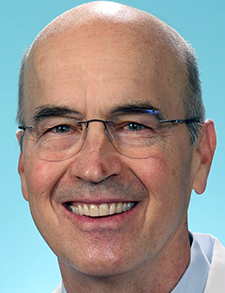
Dr. Williams
Dr. Williams quickly progressed with physical therapy from being bedbound to using a wheelchair, a walker, and then a cane. He returned to the teaching service at Barnes in September and was working seven-day blocks again on the floors by December. The first day back on hospitalist service wasn’t so bad, Dr. Williams said, but by the fourth, he realized he no longer had his former stamina—he was exhausted. The accident had made the work much more difficult.
“Thankfully, I was in good shape, previously able to take 40-mile bicycle rides. But also, lucky I wasn’t farther from a major trauma center (when the accident happened),” Dr. Williams said. The whole experience has caused him to think a lot about what’s needed to make hospital medicine a physically sustainable job for the long run. “How do we find long-term work/life balance in this career?” That issue becomes more important, he said, “as we age. Our joints don’t work as well. All things begin to be impacted by age.”
What are the rigors?
How demanding, physically, is hospital medicine? What are the cumulative impacts of walking the floors all day, not to mention the added stresses of covering the night shift? And what are some mitigating factors that might enable hospitalists to stay on the job longer, preserving an invaluable workforce for the challenges that lie ahead?
The rigors include, first of all, walking throughout a shift from one patient’s room to another, how far depending on the layout of the units and the assignment of patients. When not walking or talking to patients and staff, the alternative is sitting for extended periods typing on a laptop into the electronic health record at whatever open space has been carved out for it in a crowded hospital—likely without a lot of attention to sitting ergonomics. And that can contribute its own impacts.
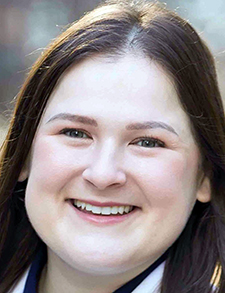
Dr. Chambers
“I think the physical demand is large, mostly a lot of standing and walking,” said hospitalist Jessica Chambers, MD, MPH, FACP, associate program director of the internal medicine residency at the University of Texas at Austin. There’s also the mental stress from the sheer number of clinical decisions that need to be made in a typical shift, confounded by the doctor’s attention constantly being pulled in three directions at once, she said. (See: Interruptions: Bad for Hospitalists and their Patients, The Hospitalist, April 2024.)
For Dr. Chambers, it was important to learn how hospital nurses manage the physical demands, what kind of shoes they wear, the orthotics, the compression socks—”how they are taking care of their bodies. I also think a lot of the time (on the job) we’re dehydrated and haven’t eaten,” she said.
“Sometimes I am actually in the hospital but talking to the patient from my office, calling their room.” It might actually accomplish more doing follow-ups by phone rather than walking 10 minutes to get to the patient’s room, she said. Other groups are exploring various applications of virtual hospital medicine, such as covering night shifts from afar when there isn’t a doctor in the hospital. And hospital at home is opening new doors for clinicians.
But what about working that night shift, given the large body of evidence of the various deleterious effects it can have on personal health? Some hospitalist groups have collectively decided that older hospitalists should be relieved of pulling night shifts. Others pay shift differentials for working the night shift.
Some hospitalists, like Dr. Chambers, actually prefer working nights, even though she acknowledged the literature showing chronic effects such as gastrointestinal problems, anxiety and depression, and even higher rates of cancer and heart disease, from overturning circadian rhythms. “That is well established in factory workers.”
For Dr. Chambers, the night shift means a different pace of work and a focus on patients experiencing medical crises, versus regular rounds visiting every patient on a panel. She might be the only hospitalist on duty at night in a 350-bed hospital, and she might see 10 to 20 patients in a shift. “I’m called when someone is acutely sick, like they’re having chest pain or trouble breathing. This breaks up the routine and makes the night interesting and dynamic.”
She also viewed it as an area of untapped potential for medical education. She built a novel overnight curriculum for internal medicine residents—who are mandated to do some of their shifts at night. “It’s a wonderful opportunity to train future doctors in a different social environment. We have precious time for learning that we don’t have on other shifts.”
Dr. Chambers typically works seven night shifts in a row, and then, for her week off, tries to reestablish a normal morning routine. What does that do to her physically? “It’s tough. The major thing I have noticed is an occasional lack of cognitive clarity.”
Continuity in scheduling
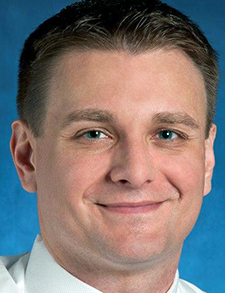
Dr. Michtalik
Henry J. Michtalik, MD, MPH, MHS, SFHM, assistant professor of medicine at the Johns Hopkins University School of Medicine in Baltimore, heads the Henry Michtalik Lab there for studying job stress and burnout. “I also lead several projects on burnout and wellness specifically for hospitalists. I also lead our morale survey, asking doctors not just about burnout but about workload, leadership, acknowledgment, resiliency, culture, work-life balance, engagement, and other areas.”
How long can a hospitalist work, on average? “That’s difficult to say because every career is unique,” Dr. Michtalik said. One of the challenges for the field is balancing continuity in scheduling, since fewer days in a row, while less strenuous, means more patient handoffs. Hopkins has tried to customize minimum and maximum numbers of consecutive shifts, he said. “Everybody has a different perspective based on how they feel at work and how to balance their personal and additional clinical or administrative responsibilities. Our shifts have fixed hours but retain some individual flexibility.”
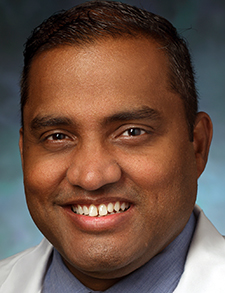
Dr. Gundareddy
Venkat Gundareddy, MBBS, MPH, associate director of the division of hospital medicine at Johns Hopkins Bayview Medical Center, drew a distinction between the physical toll of being a hospitalist, and burnout. The physical toll includes several factors, such as the number of shifts per month, duration, number of patients, how well cohorted the patients are geographically, and the run of shifts in a row.
“Seven days in a row takes its physical toll, in various forms,” he said. Some hospital medicine groups are moving away from this model, even while many hospitalists believe it is more conducive to their life outside of the hospital. “Hospital medicine as a field is relatively young, although it has grown rapidly. So how do we age well as hospitalists? How will the long-term physical and mental demands on hospitalists affect the longevity of their careers? What’s the answer to all that? I’d love to see more objective studies about this,” he said.
Dr. Gundareddy believes more resources should be devoted to this aspect of medicine—the longevity of the field—to ensure that hospitalists are able to keep working at the patient’s bedside. “What are we doing as leaders to mitigate the physical effects?” he said.
Hospitals can also start paying more attention to ergonomic issues—supportive chairs, cushions, adequate lighting, etc.—in the workstations that are offered to hospitalists. They should be stocked with coffee, water, and snacks. Experts emphasize the importance of taking breaks regularly, eating healthy meals more or less on schedule, and getting regular exercise. Reducing the number of hours per shift from 12 to 9 or 10 could also make a difference.
It might also be possible to learn from emergency medicine doctors, who are also on their feet for long periods dealing with high-intensity crises, decision making, and uncertainty. The jobs are similar, said Dr. Williams, who has done both. “Emergency medicine, as it became a specialty, was quick to recognize that doctors couldn’t do it for 48 to 50 hours per week.” So their pay was adjusted to define a full-time job as 32 hours per week.
Designing work for hospitalist health and safety
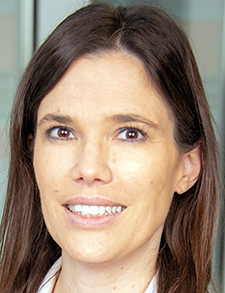
Dr. Burden
Marisha Burden, MD, MBA, SFHM, hospitalist and division head of hospital medicine at the University of Colorado School of Medicine in Aurora, is co-founder of GrittyWork, a mobile application and movement aimed at transforming clinical work through evidence-based work design. Her work focuses on understanding optimal work design, which encompasses not only its structure and processes, including workloads, but also important components that are often overlooked. That includes the physical elements of the job as well as the work environment.
“The work hospitalists do is both mentally and physically demanding and hard to fit into regular job expectations,” Dr. Burden said, “You never know when your day will end.” Physical activity, such as walking, maneuvering through procedures, and endurance, are important parts of the work. “Additionally, there are no built-in breaks during the workday, making it challenging to prioritize self-care since the goals of the day are putting patients first.”
For Dr. Burden, the fundamental question is how to build optimal work design—around workloads, work environment, and work culture. “How do we build a process and structure to support the workforce so they can do their best work, taking care of their patients in the best way possible and taking care of themselves?” She believes this is critical to ensuring the long-term sustainability of the work of hospitalists.
Her research started with the questions: How do we measure workloads for hospitalists? What is optimal work design? “I believe fundamentally that these questions also impact organizational outcomes, including financial ones. But how many in the field are using evidence-based information to determine their hospitalists’ workloads or work design?” She studied optimal ways to measure hospitalist workload by interviewing national experts, concluding that productivity-related measures and financial measures may offer an incomplete understanding of optimal workloads.1
Impact of workload
Of course, issues of aging and career longevity and the physical toll of hospitalist work are not just relevant for the clinician. What about the impact on patients’ outcomes and lives? A 2017 study comparing hospitalized elderly patients treated by older or younger hospitalists found that adjusted 30-day mortality increased with the age of the physician (from under 40 years old to 60 and above).2 However, readmission rates did not vary with physician age, and among physicians who saw a high volume of patients, there was no age-associated difference in patient mortality.
An older study from 2003 found that older physicians had decreased clinical knowledge, adhered less often to standards of appropriate treatment, and performed worse on quality measures.3 But those are process measures, not patient clinical outcomes, for which data have been scarce. Nor do they answer whether the generational differences reflect the effects of age or differences in and chronological distance from medical training.
The generation of advances in the care of hospitalized patients—new diagnostic tests, treatments, and identification of possibly ineffective prior approaches (e.g., Things We Do for No Reason)—requires hospitalists to actively invest time in learning what is the best evidence for evaluating and managing hospitalized patients, Dr. Williams said. It is an ongoing process that hospitalists should never ignore. As quoted in an editorial accompanying a 2005 Annals article, he said, “‘We must actively cultivate competence throughout a professional career.’”4
Larry Beresford is an Oakland, Calif.-based freelance medical journalist, and long-time contributor to The Hospitalist.
References
- Burden M, McBeth L, et al. Salient measures of hospitalist workload. JAMA Network Open. 2023;6(8):2328165.
- Tsugawa Y, Newhouse JP, et al. Physician age and outcomes in elderly patients in hospital in the US: Observational study. BMJ. 2017; 357:j1797.
- Choudhry NK, Fletcher RH, et al. Systematic review: the relationship between clinical experience and quality of health care. Ann Intern Med; 2005;142(4):260-73.
- Weinberger SG, Duffy FD, et al. “Practice makes perfect”… or does it? Ann Intern Med. 2005;142(4):302-3.
Please continue this research. I love my career in Hospital medicine but as I approach 55 it is getting harder to recover after shifts. We need to use EBM to learn best practices for our work.
Great topic.
The article raises some good points and generates some interesting questions in my mind.
Is the typical hospitalist workload:
– preventing the aging hospitalists from delivering their best care (resulting in higher 30 day mortality)
– prematurely ending the careers of older hospitalists?
– the etiology of the churn in our population of young hospitalists? Would they stop fleeing to subspecialty work if the conditions were more humane?
Is our schedule and workload leaching the specialty of some very bright minds?
Hopefully Dr Burden’s research will lead to the setting of some national standards…for the benefit of everyone.
My group went to a 5 day on- 5 day off schedule (12 hour shifts) by physician request. All the doctors loved it and felt less “burned out.” Despite this, the administration re-imposed 7-on-7-off because they said it was too complicated to make the other schedule. Until it is no longer a race to the bottom(line), changes will be difficult.